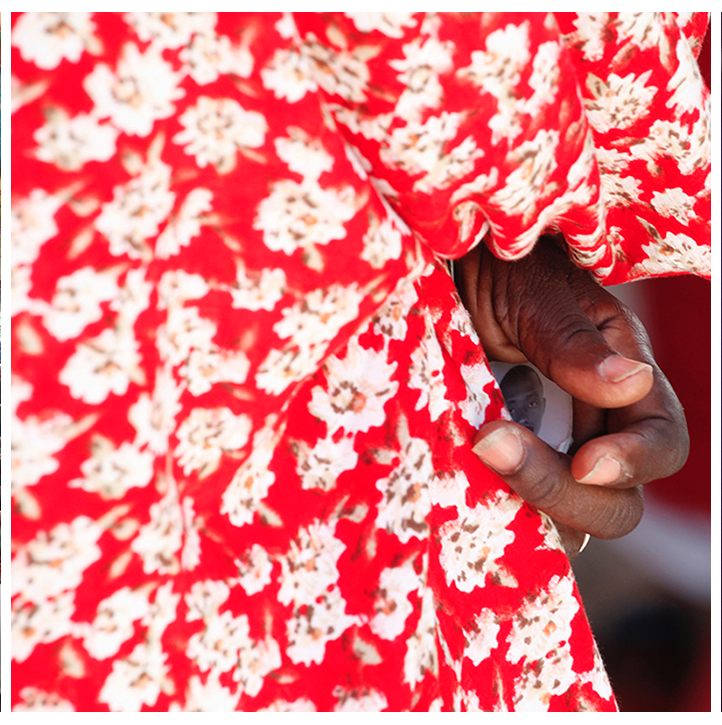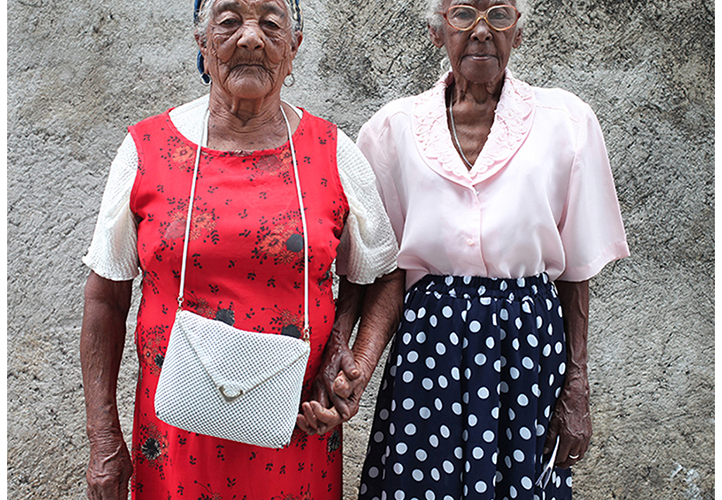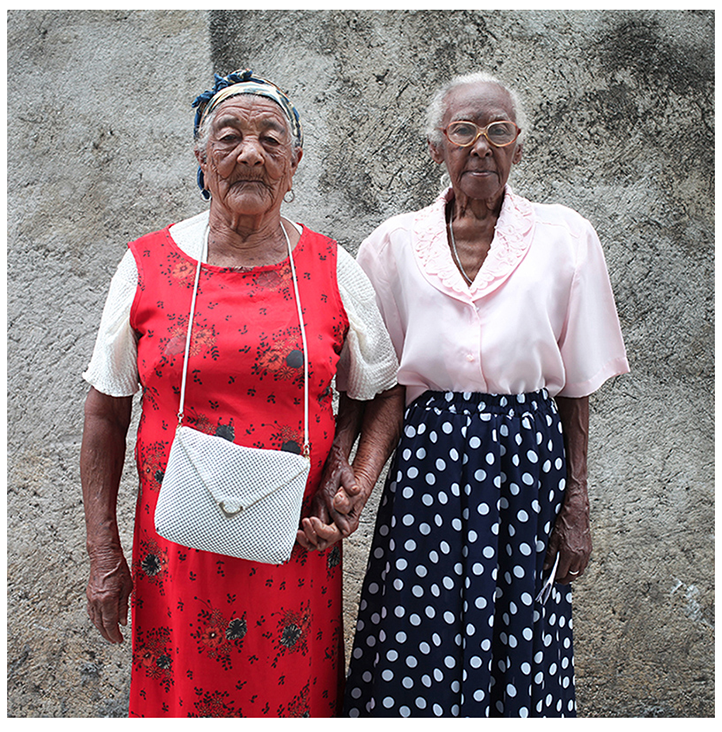
Behind the Scenes at FotoKonbit. Marie (fifth from left) with FotoKonbit Team & Students.
Used with Permission
For those of you who are new to our blog, you can check out last week’s blog post here! Today, we’re delighted to bring you the follow up to our last post and introduce Marie Arago, photographer and co-founder of FotoKonbit.
1. Could you explain FotoKonbit to our readers? How did it come about and how would you summarize your organization’s mission?
FotoKonbit is a non-profit organization that teaches photography to children and adults in Haiti. Our students are encouraged to express themselves visually and document their lives and communities with their cameras. FotoKonbit was co-founded by Tatiana Mora Liautaud, Noelle Theard, Ralph Dupoux and myself. Frederic Dupoux has also been working with us from the start. We are all photographers and artists. Maggie Steber and Edwidge Danticat have been very helpful to us as members of our advisory board.
2. Can you describe to us what is going on in one of the 5 current communities where FotoKonbit is working?
In the community of Zoranje, just outside of Port-au-Prince we have a weekly photography class with youth between the ages of twelve and twenty. The students document both their lives and community. The area surrounding the Zoranje school (as well as the Zoranje school) is a relatively new and quickly developing neighborhood. The current and future photography students at Zoranje will be photographing the development and changes in their community and lives over time. We see this group every week. Some of these photographers were able to travel around the country this past summer and photograph for National Geographic. Their images will be published sometime next year.
3. In what ways can photography through an organization like FotoKonbit benefit the communities where you work? Can you explain the impact that photography has on your students?
Photography has given our students a new outlook on their lives and communities and a way to express themselves visually. Also, over time the students have created an archive of images of their communities. Some of our students have been able to travel to places in Haiti for the first time and we had one student who was able to leave the country for the first time. We have had slideshows and exhibitions in the various communities where we work that people really seemed to enjoy. We have been able to hire some of our students as assistants from time to time and in some cases we have been able to help our students pay for their education. Some of our students have been able to make money photographing weddings, church events, portraits and funerals in their communities. Also, students have formed friendships with each other and had fun being part of FotoKonbit- which is important!
4. What have the most powerful story or image(s) captured by a student been for you?
There have been many powerful images that FotoKonbit students have made. We have one student who photographed a woman dying. I would not show that image as it was made more for the memory of members of the photographer’s community. Also not long after the earthquake we produced a series of photo workshops in various tent communities. The students were asked to photograph the positive and negative impacts of aid on their various communities as well as their daily lives and then they presented the work to an audience of people working members of the international aid community in Port-au-Prince.
Here is one of my favorite FotoKonbit images- by Marjorie Jean-Baptiste. It is photograph of a market scene in Camp Perrin. I am a fan of double-exposures and this one really works for me. It was used as a book cover for a book called “The Idea of Haiti” by Millery Polyné!

Market Scene in Camp Perrin
Photo By FotoKonbit Student: Marjorie Jean-Baptiste
Used with Permission of FotoKonbit
5. Do you have a favorite photo that you’ve taken in Haiti or abroad?
Here in Haiti I work both as a journalist, for international (and local) organizations and I make personal work. I am also pretty active on Instagram. On all of those different outlets I try to give respect to the people I am photographing and to Haiti in general. It’s hard for me to choose a favorite image. Instead I will give you two images that I like. Photography can be about making and taking. Sometimes we “take” photos before there is any type of consent because if we asked the moment would be gone. Other times we “make” images with the consent of a person- which is usually a portrait. Here is an image I made and here is an image that I took.
The two women shown in the portrait are best friends and have been for many years- I saw them walking together (while I was working on assignment for AARP) and had to take their picture. The other picture is a woman holding a picture of a man who I later discovered was her husband who had passed away. She was praying for him when I photographed her.

A woman holding a photograph of her late husband.Photo Copyright of Marie Arago. Used with Permission.
6. For those whose involvement in Haiti is best described as short term, what kinds of pictures do you think they can take that ultimately “do good”?
I am not sure if you are talking about journalists or people working for NGOs. For journalists I would say that it would depend upon the issue that they are photographing. There are some photographers who come down here and tell important stories that need to be seen and others who find more sensational issues, whether or not the images “do good” would depend upon the subject and audience. NGOs and organizations usually need pictures that will help either show the work they have done or help raise money, so I suppose if it is an organization doing good work pictures made on behalf of that organization “do good.” For images that are trying to “do good” I would prefer to see an image that played on human similarities rather than differences, if possible.
7. What do you think of photos that focus on the challenges that Haiti faces? Do these images play any role in improving the country’s condition? If yes, who should be taking these photos? If no, what kind of harm do these photos do?
I would like to believe that images can play a role in improving Haiti’s condition, but people should take care with their representation of this country, or any country, really. After the earthquake there was some irresponsible image making. Photographers came down here just to take pictures that would further their careers. Obviously, there needed to be a lot of coverage after the earthquake but it was extreme. FotoKonbit was born in that time and I think that the timing was good. It was the right time for people to see photos of this other, every day side of Haiti made by Haitians.
Photographs of Haiti made by FotoKonbit students often provide the viewer with a different perspective, usually a more intimate, relaxed view of a person or scene. I think there is room for foreign photojournalists, too. A story can be told from different angles. There are some stories that are probably photographed better by someone who has distance from the subject and vice-versa.
by Erin Nguyen on November 24, 2014
The HaitiHub staff is so grateful for the time that Marie took to answer our questions and her willingness to share some of her personal work and the work of FotoKonbit’s photographers with us! If you’re interested in seeing more you can visit the official FotoKonbit online gallery or Follow Marie on Instagram!
Mèsi anpil Marie ak FotoKonbit!
Read Part 5 in our Photography Series: Subject Matter – Who’s on the other end of your Camera?


